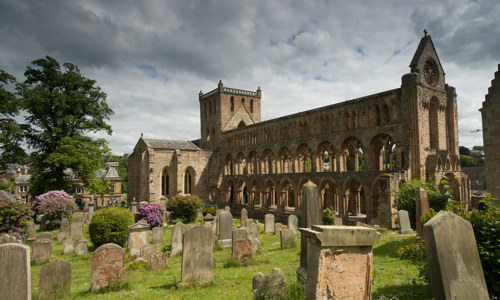History
David I founded Melrose Abbey, the first Cistercian monastery in Scotland, in 1136. It was one of a number of abbeys that he set up in the Borders to show both his piety and his power over this contested territory.
The Cistercians were drawn to this fertile spot beside the River Tweed by its close associations with St Aidan and St Cuthbert. The monks came from Rievaulx Abbey in Yorkshire, the Cistercians’ great northern English missionary base.
Monastic life continued at Melrose for the next 450 years. The last monk, John Watson, died around 1590. The crumbling abbey church was used as a parish church until a new kirk was built nearby in 1810.
A focal point of the Borders
The great abbey church of St Mary the Virgin at Melrose loomed large in the lives of many people on both sides of the border.
Powerful people endowed the abbey richly and it was a highly desirable final resting place. Alexander II (died 1249) was among the privileged people to be buried here. The heart of Robert the Bruce (died 1329) was also buried at Melrose, although his body was interred at Dunfermline Abbey.
Melrose’s location put it on the front line of conflict with England during the later Middle Ages:
- attacks by Edward I (1300 and 1307) and Edward II (1322) required major repairs
- Richard II’s attack in 1385 led to a complete rebuilding of the abbey church
- the War of the Rough Wooing in the 1540s caused further damage
Architecture of solitude
Only a very small part of the first abbey church survives. The present building of rose-coloured stone dates almost entirely to the post-1385 rebuilding. Yet Melrose is still considered one of the most magnificent examples of medieval church architecture anywhere in the British Isles.
Still remarkably intact are:
- the presbytery at the east end, where the high altar once stood
- the monks’ choir and transepts
- part of the nave
Highlights of the interior include the ornate stone vaulting over the presbytery, the elegant piers and the window tracery (carved stone separating the glass).
The exterior is decorated with some of the most fascinating sculpture found on any medieval church building.
It depicts:
- demons and hobgoblins
- lute-playing angels
- cooks with ladles
- the famous bagpipe-playing pig
Everyday monastic life
Little remains standing of the two great cloisters that lay to the north and west of the abbey church, but their ground plans are largely complete. These provide a glimpse of monastic life.
Finds made here include everyday objects like:
- cooking pots
- portable urinals
- floor tiles
There is also a precious fragment of the shrine of St Waltheof, the second abbot.
The various objects are displayed in the (restored) Commendator’s House, built in the late 1500s.













